How does one stay awake during a midnight drive interstate? In the many years of drives in the dead of the night, I found that there are three essential things. One, a few cans of coffee bought over the petrol station counter. Preferably black and roasted, if not, a latte would do. Two, the radio blaring loudly. I usually have it on a rock or dance playlist with enough BPMs (beats per minute) to keep me constantly moving. Finally, an engaging conversation.
These three are essential during a drive either early in the morning, or late into the night.
I find myself, again, on the road at 4 AM in the morning with the boys. This time, we were en route to Melaka. I had plans to research and learn more about cincaluk, a condiment native to Melaka. If the East Coast had budu, fish sauce – cincaluk was its Southern-sibling, separated by landmass and made from fermented shrimp. The drive was long. Two hours was the bare minimum for a traffic-free drive from Kuala Lumpur to Melaka.
We arrived around 6 AM, just in time to catch Subuh prayers at the Melaka Straits Mosque, and being disappointed by the lack of a decent sunrise. The sky was muddy. I hoped this would not be an indicator for the rest of the day.
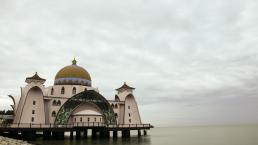
After breakfast, we made our way to Tanjung Kling where a belacan-making workshop was located. Unfortunately, we were not so lucky. The person in charge of conducting the belancan workshop was away – of all days. However, the workers at the workshop were kind to share with us some basics behind the belacan-making process.
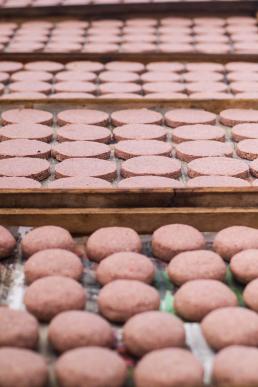
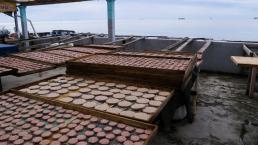
Belacan only requires a combination of two ingredients: geragau shrimp and salt. After mincing the shrimp, and mixing it with salt – the mixture is packed tightly into either a patty or disc-shaped. Afterwards, the belacan is left to dry for up to a week minimum.
Alternatively, some are burnt to hasten the process. Those that do carry the scars of chars and burn-marks, turning white-pink instead of the usual dark-pink that comes with natural drying. On days like today, when the weather is gloomy and the sun scarce, the workers place the freshly-packed belacan on the grill and burn them for hours on end.


A long-gone geragau industry
While exploring Tanjung Kling, we met a man who looked to be in his late 60s. Mat Jali Ibrahim is a fisherman around these parts, and used to make a living from the sea. More specifically, he used to catch geragau shrimp that forms the belacan and cincaluk economy of Melaka. However, the state government’s aggressive land reclamation efforts has since decimated the local geragau industry.
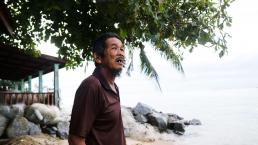
Mat Jali draws lines in the sand, describing how back then fishermen only needed to wade by the shore, cast their nets and haul in a good amount. The geragau shrimp, delicate, white in color and miniscule in size, reside by the shoreline. In Melaka, they are found along select shorelines such as Klebang, Tanjung Kling, and Kuala Sungai Baru. During peak season, they sell for RM4 to RM5 per kilogram. This supply chain is what supported Melaka’s star condiment, the cincaluk, made of fermented geragau shrimp.
Much of this is now gone. The current geragau supply now comes from Johor, Mat Jali claims. He also adds that the abundance of cincalok sold throughout the state are not locally-produced. There is a sadness in his voice when he says this.
The land reclamation projects had pushed the shrimps further out and had effectively destroyed both the fertile ecosystem and the reach of shore fishermen. Nowadays, Mat Jali spends his time repairing fishnets, and complains about the rising cost of items. As he laments these changes, he points towards a nearby Tanjung Bruas port-jetty and shares how it had affected his village’s economic and environmental livelihood. He is keenly aware of local politics and how the global trade had affected the livelihoods of his peers. An example he shared was the presence of the many tankers that restricts how much the local fishermen could yeild.
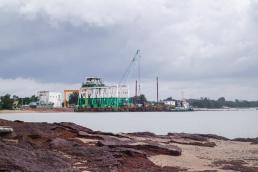
Mat Jali’s ruminations on how the state government’s development projects and how it affects the livelihoods of those living along the shoreline is emblematic of the larger issue that is going on with Melaka.
As we drove around Melaka city, two things are noticeable: the desolate empty commercial lots and the great number of projects and developments designed for mainland China tourists.
In 2016, the federal government officially embarked on an economic partnership with China. This was reflected in the many different China-backed projects that took hold across the country, such as the East-Coast Rail Line (ECRL), Kuantan Port, and Forest City development. Under the Asian superpower’s Belt and Road initiative, Melaka entered into an RM8 billion Melaka Gateway development project. Melaka Gateway was intended to uplift the state’s economy, mainly through land-reclamation projects that would lead to developments.
Use the interactive Google Earth Timelapse above to see the the changing shoreline of Melaka through land-reclamation projects.
Many years since, and the Melaka Gateway project was terminated. While this was one part of many, one could see the remnant of an ambitious project turned white elephant. There were a staggering number of abandoned developments in desolate areas. Many completed projects, such as Encore Malacca, laid bare a plan to accommodate to China.
When examined closer, the performance of Encore Malacca is curated and designed by Wang Chaoge, a Sino-native who was the Director of the 2008 Beijing Olympics opening ceremony. The performance narrates the origins of Melaka, but is infused with influence from the Chinese Empire through the inclusion of Admiral Cheng Ho, who formed diplomatic ties with the Melaka Empire. From an architectural perspective, the modernist building was designed by renowned Chinese architect Wang Ge. Clearly, the project was made by and for Chinese nationals, and was a pivot towards Sino-tourism.
These projects now sit mainly abandoned, although if one were to continue down the shoreline, they would see several small instances of land reclamation continuing. For one like myself, the Melaka of today is strangely different from the one I remember many years ago. Due to the aggressive land reclamation projects, areas that once used to be by the shore are now no longer. There is a larger story here about Melaka being a state of expensive white projects, and a waste of public funds. One more suited for another time.
Pulau Konet & Pulau Keramat
After lunch, we decided to seek out Pulau Konet. The mini-island was first sighted by Asyraf, and from what he knew, it was one of the few instances a sandbar naturally occurs on this side of the Peninsular. The drive from central Melaka up to where the island was took us down a series of spindly networks. We soon arrived, making our way down a single-lane road and passing by a Chinese graveyard. And by the shore, Indian graves. I am made to believe then, from this impression, that the ashes of the deceased were likely scattered in these parts.
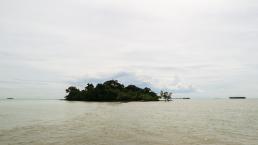
When I first set foot on the shoreline, I was unsure if I could cross the sandbar – hidden underneath the waters. In the distance however, we saw a man braving the waters and trudging back to shore. That emboldened Adi, and he encouraged me to follow him. In a lack of foresight, I forgot to bring along a pair of sandals. Crossing the sandbar is no joke, and I was at risk of cutting myself on sharp rocks I may not be able to see.
The man, who had finally arrived back on shore, gave us a report of the island and told us it was not a difficult feat. Izzat (the man’s name), was kind enough to borrow me his sandals, three sizes larger than my feet. He wanted me to enjoy and share the experience and I was grateful. So Adi and I went forward into the high tides. Because it was sometime in the late afternoon, the waters were not as high and reached only up to our calves.
The challenge in this instance was to be able to make out the sandbar and slowly walk towards Pulau Konet. We braved the tides, and after ten minutes or so, made it to the small island. There was not much to see, but it was an accomplishment nonetheless.
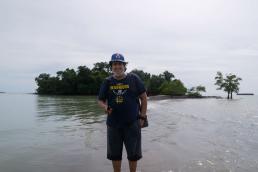
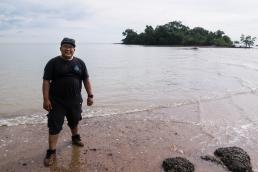
While Pulau Konet is well-documented in the news, not much is known about its twin-island, Pulau Keramat. The other island is less than a five-minute walk away, with similar features as Pulau Konet, but does not have the same feature of a disappearing sandbar. However, it appeared that Pulau Keramat had more significance to the local villagers compared to the other island.
“Both these islands -” a male villager waved in its direction, “Used to be part of the shoreline. But when the Japanese came and bombed this part of the state, the impact split the shoreline into two islands”. It was hard to verify if this tale was true, and my cursory research of colonial and war-time maps in pre-Independence Malaya did not surface any satisfying answers.

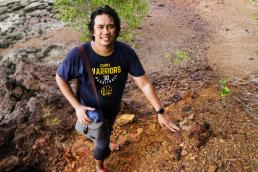
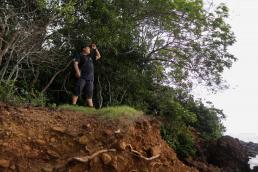
We were also informed by the villagers that Pulau Keramat hosted the grave of a former village chief, and had been so for generations. We made attempts to explore the small island but failed to do so. The thick bushes and shrubs made it difficult to navigate into the heart of Pulau Keramat, so we abandoned the search.
The entire time we were in the area, we observed men casting nets into the sea, hoping for a catch. These were amateurs, who likely did this as a hobby and to pass time through conversation and reflection. They came back to the shore with little, but a modest catch of small crabs and maybe a few fishes. No geragau here.
By the time we were done, it was close to dusk so we made our way further North to Fort Supai, a former Dutch Fort outpost. The area, although well-kept was in need of some maintenance and grass-cutting. As we walked around the aged structure, it was empty and seemed to be used as a park of sorts. Fort Supai, like many other minor heritage sites around the country, faced the fate of lack of maintenance, and genuine historical appreciation.
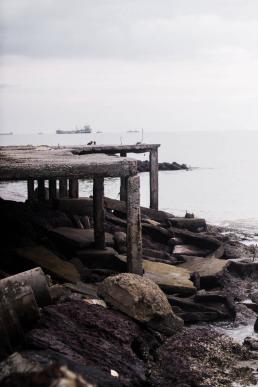
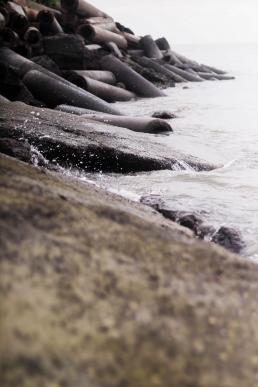
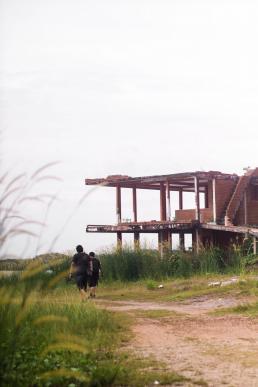
Unlike most our of adventures, Melaka felt tamer than the rest. Perhaps the revelation of a state over-run by white elephant projects and a Sino-handover gave the rest of the trip a sharp pierce of reality. At least for me. Everywhere we went, we saw abandoned buildings, decaying into time. Melaka’s livelihood ran on tourism in the city, but outside in its rural districts, much depended on industrial developments. Was this a fate the state was confined to?
When we studied here almost a decade ago, the reality of a Melaka, a heritage state was still clear. I remember exploring the city streets that told stories of a colonial and empire past. But perhaps I was shielded from what was happening outside the city – where incremental changes to the economy led the state to where it is now: many land reclamations later, a long-gone geragau industry and a state desperately clinging to its glourious past.
Asyraf’s Jalan Lihat Dengar has turned our Melaka trip into a two-part series, which you can watch below: